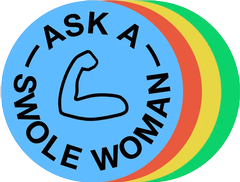Sick of clean eating, perfect gym outfits, and chiseled abs? A Swole Woman is here to help you be healthy, enjoy carbs, and get jacked.
-CassidyWhat warmups or warming-up stretches do you prefer?
-CicelyThe thing about warming up is that there is no universal, agreed-upon answer about how to do it, but there’s universal agreement it’s important. There are a lot of options, such as static stretching (holding a stretched position, like touching your toes, for a sustained amount of time); dynamic stretching (using mobility movements to get warmed up, like leg swings or arm circles); muscle “activation” (movements that are meant to wake up an athletes’ particular “weak” muscles); foam rolling; cardio; “prehab.”
Advertisement
Mobility has become a huge topic since CrossFit and “functional fitness” got popular, and warming up is a huge part of maintaining that, as well as preventing injury and making sure your workouts go as safely as possible.Warmups don’t need to be complicated, because if you have no particular bodily needs—no injuries you are nursing, no particular stiffness or lack of mobility you’re trying to tease out—all your warmup needs to do is get your blood flowing by “moving around.” Warmups tend to skew more complex when athletes start feeling some of their muscles are tighter than others, or some muscles more underused than others, or they’re managing an injury, and they begin adding in movements or positions that address their particular issues.Now, in recent weeks, we have the added complication of “we’re all stuck inside and there’s maybe not even a lot of room to move around.” But basic warmups are extremely easy to do at home, and unless you have some sense of your specific needs, you can do whatever appeals to you. If you’re still trying to build the habit of working out, you might try just committing to a short warmup routine every day for a week, and then rolling that into a more rounded-out workout. Here are some recs for the lower-stakes varieties of warmups that pretty much anyone can do.
Advertisement
Static stretching
Advertisement
Dynamic stretching/warming up
Cardio
Advertisement
Warmups are a little tricky because they could theoretically be endless. There are a lot of muscles in your body, and warming up activating and stretching each one could literally take all day. (This is thoroughly unnecessary.) But my goal is to start my workout without feeling tight or stiff, and as I’ve moved toward being a little less of a beginner, primed to do my workouts’ movements a little more optimally than before because I targeted my warmup correctly.Warmups can evolve continuously, too. My warm ups have been as simple as running a few blocks around my gym, and as complex as 20 minutes of stretching and prehab-type movements. The warmups of other members of my gym (before it closed) were, to be absolutely romantic about it, like fingerprints; no two were alike. Now that I'm stuck at home, I haven't been as good about warming up because I dread at-home workouts more than going to the gym. But when I don't do it properly, I always pay for it.For me, this evolution process involved learning to pay attention to my body, but also getting advice from coaches and physical therapists about pains or issues I was having in order to address this or that problem. I add in movements as I need them and retire others, and while I’m sure I’m not doing this as perfectly as I could be, I’ve caused myself no serious injuries by following a mix of professional and casual advice, and doing what feels good.It’s completely natural for personal physical challenges to evolve; as some muscles get stronger, they can be overtaxed, strained, or tight. In other cases, maintaining fitness or pursuing progress may mean addressing weaker areas. As one example, piriformis syndrome is a fairly common problem with many possible causes, one of which can be overly aggressive exercise or weak supporting muscles. Some ways of addressing it involve rehab to activate those supporting muscles, or relieving tightness in the muscle itself by stretching; if you’re having developing or nagging issues, a sports medicine doctor or physical therapist can be an amazing help in figuring out more customized ways to address problems that arise as you continue to work out.Warming up is not something to stress a ton about, particularly if your workout is more of the moving-around-for-a-while variety than the intense-progress-of-your-physical-prowess variety (Stronger By Science has an even-more scientific breakdown of warm-up activities, if you’re interested to read more about it). Barring some risky condition or injury, that you do it at all is more important than what you do specifically.Disclaimer: Casey Johnston is not a doctor, nutritionist, dietitian, personal trainer, physiotherapist, psychotherapist, doctor, or lawyer; she is simply someone who done a lot of, and read a lot about, lifting weights.You can read past Ask A Swole Woman columns at The Hairpin and at SELF and follow A Swole Woman on Instagram. Got a question for her? Email swole.woman@vice.com .

